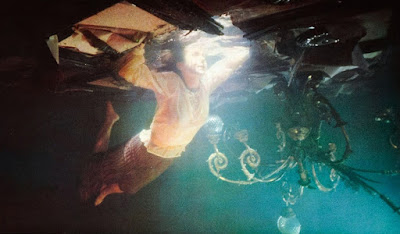 |
From https://a.ltrbxd.com/resized/film-poster/7/6/4/0/9/76409-
death-powder-0-230-0-345-crop.jpg?k=3bdaf1aa36 |
Director: Shigeru Izumiya
Screenplay: Shigeru Izumiya
Cast: Shigeru Izumiya; Takichi
Inukai; Rikako Murakami; Mari Natsuki; Kiyoshirô Imawano
 Synopsis
Synopsis: In an unknown time period in the future, three
individuals preside over a female android called Guernica (
Mari Natsuki). Two of them, a man (
Takichi Inukai) and a woman (
Rikako
Murakami), must contend with the third, an older man played by the film's
director
Shigeru Izumiya, who has
become protective of Guernica to the point that he will harm his compatriots
immediately on sight. Mutants are after them as well, and when Guernica
projects a white powder from her form over one of the central trio, it induces
mutation and hallucinations culminating, once the body becomes too weak for the
growing consciousness, to a horrifying transformation for the whole trio.
2022 Writer's Edit: This is not the only feature made by Shigeru Izumiya, contrary to the original review. There is at least one credited before Death Powder on IMDB, called The Harlem Valentine Day (1982), so this review has this correction.
Death Powder is the only feature made by Shigeru Izumiya, who is more well known as a political and very prolific
folk singer who also acts a lot, including voice acting in the Studio Ghibli film Pom Poko (1994). You don't expect, say, Bob Dylan to create a cyberpunk predecessor sandwiched between the
early films of Sogo Ishii or Shinya Tsukamoto's Tetsuo: The Iron Man (1989), but it wouldn't have been a surprise
if Izumiya created a film entire for
his own desires, the result of which should prove him proud in how confounding
it is. There is a caveat however to this review which in its own way adds to
the mysterious tone of Death Powder
- the version I had access to, as for many, doesn't translate everything with
English subtitles, confounded by the fact there's passages that were subtitled
in Japanese either because the dialogue wasn't audibly clear or it was a
directorial choice. Because of this I had to watch the film not fully grasping
it all, thrown in fittingly into the deep end of a mood piece with material not
in my grasp, where sperm are superimposed over cityscapes and later when the
hallucinations kick in.
 |
From https://s-media-cache-ak0.pinimg.com/736x/e8/
f2/ef/e8f2ef53903ff3336027907f4533b967.jpg |
The issue for the viewer will be
that the film jettisons its reliance on a plot very early into itself. Death Powder is only sixty minutes
long, and while back-story and plot threads are constant, a large percentage of
the film is consumed by rapidly interchanging sequences. Once one of the central
trio is contaminated by the titular powder, the film is mainly a collage of
actors being filmed in various positions and post production visual effects. For
some viewers this'll be a terrible movie because it doesn't really gel into a
narrative feature with a framework, at a cut-off point after the set-up turning
into a series of segments and images. (Baring in mind the lack of subtitles for
me in some places), one is left with many questions unasked even after viewing
the film twice. The use of sperm imagery, or actors superimposed in front of
numbers and mathematical equations. When the female protagonist is named Norris
of all things, or the point of the powder existing in the first place. One is
meant, especially in the version I saw, to detach oneself from a rational frame
point and enter the film by its terms, for others Death Powder having the potential to be rewarding as it perfectly
captures a fever dream in presentation.
 |
| From http://www.filmbizarro.com/screenshots/deathpowder/deathpowder2.jpg |
One thing that is perfectly clear
is that through the powder created from Guernica - who's name pointedly is the
same as the famous Pablo Picasso
painting representing a bombing during the Spanish Civil War (although whether
the reference was intentional for any reason is unknown) - induces a higher
form of consciousness on the person infected by it, causing them to have their
faces shred their top layer like fruit and for a drastic mutation to take
place. The end result is not necessary of a positive thing, but an evolution
takes place, where people become one giant individual consciousness; imagine Neon Genesis Evangelion: The End of
Evangelion (1997) only taking place in an abandoned building with a mass of
eyes and facial features being created, one including irregular shapes and a
flicking tongue that is both comical and disgusting. The Japanese cyberpunk
films made after this one including animation like Akira (1988) were just as likely to depict concepts like body
horror and transcendentalism as they would the tropes of corrupt government or
dystopian cityscapes; from a foreigner's view, Japan is half some of the most advanced
metropolises in the world and half its history including mythology and
spiritualism, both of which can still be found in films like this in how the
mind is just as much a concern as the physical environment.
Plot points do appear. The
mutants, consisting of a patchwork mask wearing man in a wheelchair, one near
the beginning and two stretched rubber face goons, briefly appear at times to become
a problem for the central trio. There's also the origins of Guernica, where her
creator Dr. Loo (Kiyoshirô Imawano)
has a music video for a flashback sequence and gets to tell another person to
not try to make sense of the events around them, as pointed a choice of
dialogue as you could get for the work's mindset. Baring these and some moments
of sudden violence, including a rubber hand being cut off, Death Powder spends most of its length under a single, prolonged
hallucination where creation and death intermingle through a series of images. This'll
be drastically different for anyone who is a fan of other cyberpunk films like Tetsuo: The Iron Man as this feels more
like an experimental film in its desire to not follow plot points.
 |
| From http://i45.tinypic.com/2d9cnpw.jpg |
Technical Details:
A low budget work, Death Powder emphasises the run down
urban environments that are important for Japanese dystopian films very well,
even to the point of just filming an ordinary and well kept street outside in
the day. Far from a deterrent, many of these films like this or Rubber's Lover (1996) are greatly
helped by warehouse rooms, corridors and city streets being the only available
locations, the claustrophobia of the former and the lack of fantasy of the
later adding a grounded tangibility to the content. The film also includes the
(almost) required scene for any Japanese cyberpunk film of having an outdoor
scene shot with real bystanders nearby.
Makeup and prosthetic effects are
sparingly used but are suitably unsettling. In most Japanese genre films, even
kaiju movies like Godzilla (1954),
there is a very unique and vastly wider sense of the manipulation and changing
of the human body than from other countries, where mutation to the fantastical
all have the potential to be depicted in truly imaginative ways which cause one
to re-evaluate the original object (or limb or person etc.) in a new light.
(Only Canadian cinema has such a consistency to match it). While the content is
minimal, Death Powder shares an occasional
moment of such unpredictability, the malformed consciousness of many people at
the end the most extreme example. Less impressive are the eighties video
effects, including actress Rikako
Murakami punting a frame of the film shrunk down into a box across a room
to represent another character being kicked the same direction. I'll admit its
memorable but alongside the computer added text in the film, which evokes
American shot-on-video films from this era, it does betray the movie in look.
The music is also strange. Whilst
some of it does work, I do wonder about the juxtaposition of the grim ending
with such jovial end theme music, whether it was intentional for irony or not.
 |
| From http://www.filmbizarro.com/screenshots/deathpowder/deathpowder5.jpg |
Abstract Spectrum: Expressionistic/Psychotronic/Weird
Abstract Rating (High/Medium/Low/None): Low
A unique issue with rating Death Powder is that I have viewed it
twice without the ability to speak or read Japanese and making up for that
which wasn't translated. The fact we even have access to the film with English translation
is worth being grateful for, but I have to wonder if more knowledge of what
takes place in the film would be available to me if I have access to what
wasn't translated. Besides this there is a debate however, from what is there,
whether it's the mood or the visual effects which are why Death Powder is an abstract film, this sort of cinema meant to take
a viewer to unchartered waters rather than rely on surface appearances like the
post production effects.
There's plenty of unconventional
moments crammed into Death Powder to
justify its rating, from the superimposed images of sperm to the constant
transitions into various realities, delivery employees being absorbed into a
mass conscious to its dreamlike tone, so this isn't an issue. I will admit that
a film like Tetsuo: The Iron Man and
Rubber's Lover however have a
greater intensity to their tones which make them the more abstract of this sub
genre. For the simple reason that more happens in them because of their longer
length is a factor, as if the kind of content in those films. In Death Powder's favour, the effect of
watching the entire sixty minutes if you can engage with the tone does effect
you, a disorientating effect that works in lieu of the lack of a fully formed
narrative.
 |
| From https://cinemasatori.files.wordpress.com/2011/02/deathpowder19.jpg |
Personal Opinion:
Whatever my opinion on Death Powder, as one of the first
Japanese cyberpunk films made its worth my hat to it. This subgenre is only
small but it's been one of the most rewarding for me of Japanese cinema, with a
distinction to it from that nation is contrast to sci-fi from other countries.
Death Powder is amongst the grubbiest in tone, not just for having to watch a
VHS rip, but for how it was clearly made for its own sake with what resources
were at hand. Death Powder also
opens the door to an even obscurer area of Japanese genre cinema to me, that of
films even lower budget than underground films like Tetsuo: The Iron Man which didn't even last over an hour, usually
splatter horror films from the eighties which grew out of the VHS boom. Most are
unavailable, but the internet exists and I wouldn't be surprised if I explored
any I could get my hands on.
As for Death Powder itself, it's far from perfect, having needed a bit
more to its bare boned form to be better. Not necessarily more plot either, but
an additional thing to have helped it stood out more. What is there however,
was suitably disorientating and volatile, and those are virtues hard to
accomplish in any film.















































